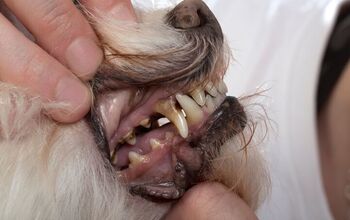Put a Lid on Bossy Barking

Canine vocalizations can have a number of meanings, expressing everything from elation to fear. If you consider your dog’s barking a nuisance or problem, it’s important to identify the underlying emotions for the outburst. The Bossy Bark generally indicates frustration intolerance; that is, the dog gets frustrated because he wants that food/ball/attention NOW. By implementing a few rules based on force-free training, you can teach your pup patience, which will in turn reduce or stop the bossy barking.
Why does a dog bark at you when he wants something? Well, because it works! Your clever dog will learn that, when he makes a fuss, you might give in. Then he gets extra treats or a longer game of fetch. The solution to this is simple but takes consistency. You will teach your dog to say “please” by sitting (or offering another polite behavior) whenever he wants something. Should he start making a racket or jumping on you, you will give him the opposite of what he wants: he will get ignored. If he is consistently given only two scenarios — sitting gets him what he wants and being rude gets him ignored — he will learn to make the right choice on his own. With time, he will automatically sit for whatever he wants, right off the bat. Now that’s a polite dog!
Rude Behavior is Ignored
Starting this moment, any time your dog demand-barks at you, he gets ignored immediately. Avoid saying anything, including “shhh,” as even negative attention can encourage him. Follow these steps.
- Hold a toy or treat that your dog likes. The moment he starts bossy-barking for it, turn your body away and do not say anything. Make sure you respond to the first sign of impatience, which sends the clear message that you will not cater to his barking.
- Once he has quieted down, you can acknowledge him again and proceed to “Say Please” below.
Say Please
Ignoring will teach your dog what he shouldn’t do, but that’s only half the equation. Say Please teaches him how to perform a polite behavior instead. For most dogs, Sit is the universal polite behavior, but a Down or Stand will work just fine, too. Your dog is welcome to request his toy, food, or leash, but you will only respond if he sits first. Follow these steps.
- Hold a toy or treat. If your dog barks or jumps, ignore him as above.
- When he has stopped barking, turn back facing him and silently wait.
- Eventually he will think to sit. Say “good dog!” and reward with the item he wanted.
You may have to turn around several times before your dog can focus on sitting. Be patient. Also notice that I don’t use the verbal cue, “sit,” here. Let your dog figure out what it takes to get that goodie on his own. By making him think it through rather than just telling him what to do, you’re setting him up to make more good decisions in the future.
Repeat these steps every time your dog wants something from you, whether it’s an object in your hand or a “service” such as getting a door opened, getting invited on the couch, etc. By being consistent on your end, you’re giving your dog clear guidelines by which to live. If you give in once in a while, keep in mind that it will confuse your dog in the long run. Rules are much harder and more frustrating to follow when they are enforced intermittently. Stay strong and be consistent, and you’ll reap the rewards with a more patient, quiet dog.

Kate Naito, CPDT-KA, is a dog trainer at Doggie Academy in Brooklyn, NY, and author of the training book, "BKLN Manners." She draws upon her experience as an educator and dog trainer to apply positive training techniques to a challenging urban environment. Kate is a rescue advocate drawn to special-needs dogs and currently has two Chihuahua mixes, Batman and Beans.
More by Kate Naito























